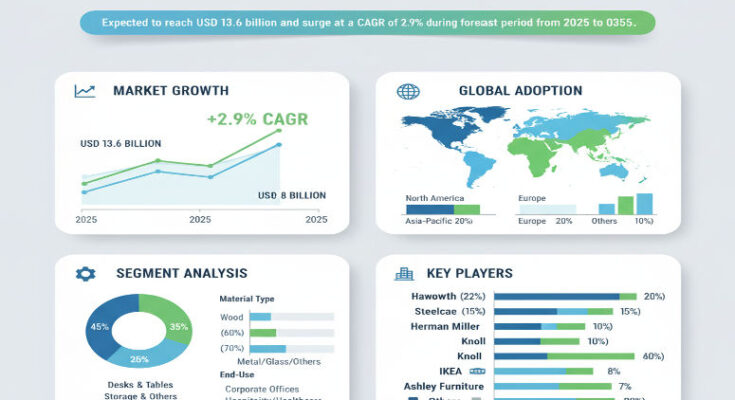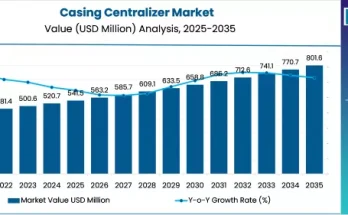The global reception furniture market is projected to grow from a value of about USD 10.2 billion in 2025 to approximately USD 13.6 billion by 2035, representing a compound annual growth rate (CAGR) of about 2.9% over that decade. This trajectory reflects steady adoption of reception area furniture solutions across corporate offices, hospitality venues, healthcare institutions, and public spaces — driven by evolving design norms, demand for functional and aesthetic reception spaces, and modernization of commercial interiors.
Market Drivers & Industry Trends
Key drivers supporting market growth include increasing investment in modern office infrastructure, where reception areas are not only functional zones but also brand touchpoints. Companies are placing greater emphasis on first impressions, visitor experience and corporate identity, which is driving demand for reception furniture that combines design, comfort, and brand alignment.
Another factor is the shift toward modular and flexible furniture systems. Reception furniture providers are integrating modular seating, configurable desks or counters, and layout adaptability to optimize space usage in reception areas. As commercial spaces embrace flexible and reconfigurable designs, furniture manufacturers are responding with more versatile products.
Additionally, the integration of ergonomic features and smart furniture elements (e.g. built-in charging, digital signage integration, or configurable counters) is becoming more common. These functional enhancements improve visitor comfort, support operations, and align with broader digital office infrastructure upgrades.
Product & Material Segmentation
In terms of product types, sofas and chairs are projected to dominate the market, capturing a large share of demand (roughly 45%) in reception furniture offerings. This is because seating is a core element in reception zones, used for visitors, clients, or waiting guests, and is often the focal point of reception layouts.
Other product categories include desks/counter solutions (for reception desks or check-in counters), tables (coffee or side tables in waiting areas), and specialty accessories (decor, partition elements, or accessories integrated into reception spaces).
On the material front, wood is expected to lead among materials used in reception furniture, accounting for around 40% share in 2025. Wood remains popular due to its aesthetic flexibility, perceived premium look, durability, and ability to adapt to different finishes or styles suitable for corporate reception environments (warm finishes, veneers, custom treatments).
Regional Insights & Growth Opportunities
Regionally, growth is influenced by both mature markets and emerging geographies. East Asia, North America, and Western Europe are identified as key strongholds for reception furniture demand. In developed markets, demand is driven by corporate offices, hospitality chains, institutional buildings and public service reception spaces, where higher budgets and design expectations support premium furniture adoption.
Emerging economies in Asia, Latin America, and parts of the Middle East are also becoming notable growth markets as office construction, hotel development, and institutional infrastructure expand. As local businesses modernize reception and waiting areas, they increasingly invest in better furniture to improve visitor experience and brand positioning.
Competitive Landscape & Key Market Players
The reception furniture market features established office / contract furniture manufacturers and commercial interior furniture suppliers. Leading players include well-known global brands such as Steelcase, Herman Miller, Haworth, HNI Corporation, and Teknion, among others. These companies are active in providing reception furniture solutions tailored for corporate, hospitality, institutional and premium commercial reception spaces.
Competition is driven by product innovation (modular / configurable systems, ergonomics, material finishes), brand reputation, distribution networks, after-sales service (installation, custom design, maintenance), and partnerships with designers or interior firms. Players are also expanding globally, adapting designs to local tastes and standards in emerging markets.
Challenges & Market Restraints
Despite steady growth, several challenges remain. One constraint is cost sensitivity in lower-budget projects, particularly in emerging markets or smaller businesses, where budgets for reception fit-outs may be limited. Premium materials and design features may be less accessible.
Additionally, the need for custom solutions (custom dimensions, branding, finishes) can increase lead times and complexity, especially for bespoke reception counters or seating arrangements. Logistical issues, installation requirements, or compatibility with existing reception area layouts may pose barriers.
Another restraint is the slower renovation or refurbishment cycle in some public or institutional buildings, which may delay replacement or upgrade of reception furniture, leading to slower refresh demand in certain segments.
Future Outlook & Strategic Imperatives
Looking ahead to 2035, the reception furniture market is expected to grow steadily, reaching around USD 13.6 billion. The market will benefit from continued corporate office fit-outs, hospitality expansions, institutional infrastructure improvements, and higher design expectations in reception zones.
For manufacturers and suppliers, strategic priorities should include offering modular and configurable furniture solutions, emphasizing ergonomic seating and visitor comfort, and expanding presence in emerging markets. Developing lighter, flexible designs with modern materials and finishes, plus integration with digital office infrastructure (charging points, digital signage, smart desks/counters) will help differentiate offerings.
Partnerships with interior designers, commercial real estate developers, and hospitality operators can help tailor reception furniture to local design trends and regional preferences, supporting market penetration in both mature and emerging geographies.
Browse Full Report: https://www.factmr.com/report/reception-furniture-market
Editorial Perspective
Reception furniture is not just about chairs and desks — it is a strategic component of corporate identity and visitor management. As businesses and institutional facilities modernize, reception areas are evolving from purely functional spaces into curated brand environments. The next decade will see reception furniture evolve with modularity, ergonomic design, premium materials and digital integration. Suppliers who anticipate evolving design trends, adapt to regional preferences, and deliver flexible, well-finished reception solutions will be well placed to benefit from this steady growth through 2035.



